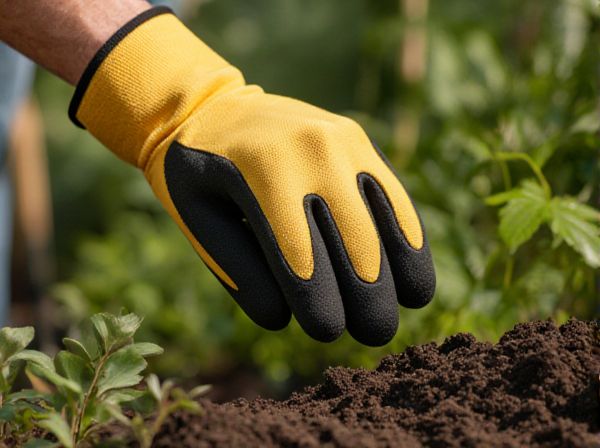
Double digging vs No-dig gardening Illustration
Double digging improves soil aeration and drainage by loosening two layers of soil, which enhances root growth and nutrient absorption. No-dig gardening preserves soil structure and microbial life by avoiding disturbance, promoting natural decomposition and weed suppression. Both methods support healthy plant development but differ in labor intensity and impact on soil ecology.
Table of Comparison
| Aspect | Double Digging | No-Dig Gardening |
|---|---|---|
| Soil Structure | Loosens soil, improves aeration and drainage | Preserves natural soil layers, enhances soil life |
| Labor | Labor-intensive, requires extensive manual effort | Low labor, minimal disturbance |
| Weed Control | Weeds uprooted during digging but may regrow | Suppresses weeds via mulch layers |
| Soil Microbial Health | Disrupts microbial networks and fungi | Promotes diverse microbial and fungal communities |
| Soil Fertility | Enhances fertility by incorporating organic matter deeper | Builds fertility gradually via surface composting |
| Water Retention | Improves drainage, may reduce moisture retention | Increases moisture retention with mulch and organic layers |
| Plant Root Growth | Encourages deep root penetration | Supports natural root development without disturbance |
| Long-Term Sustainability | Can lead to soil compaction over time if overdone | Enhances soil health and sustainability |
Understanding Double Digging: Definition and Process
Double digging is a soil cultivation technique involving the removal and loosening of two layers of soil to improve aeration, drainage, and root penetration. The process typically begins by digging out a trench one spade deep, loosening the soil beneath without mixing the layers, then moving to the next trench and filling the first with soil from the second. This method enhances organic matter incorporation and soil structure but requires significant physical effort and time compared to no-dig gardening methods.
No-Dig Gardening: Principles and Techniques
No-dig gardening emphasizes maintaining soil structure by avoiding mechanical disturbance, which preserves microbial life and enhances organic matter retention. This technique relies on layering compost and mulch to improve fertility and moisture retention, promoting healthy plant growth through natural processes. It reduces soil erosion and compaction, fostering a resilient ecosystem that supports beneficial organisms such as earthworms and mycorrhizal fungi.
Comparing Soil Health: Double Digging vs No-Dig Methods
Double digging aerates soil deeply by manually loosening layers, enhancing drainage and root penetration, but can disrupt microbial ecosystems. No-dig gardening preserves soil structure and biodiversity by layering organic matter on the surface, promoting natural soil health and beneficial microbial activity. Studies indicate no-dig methods improve long-term soil fertility and carbon sequestration more effectively than double digging.
Impact on Soil Structure and Microorganisms
Double digging disrupts soil layers by deeply turning and loosening soil, improving aeration and root penetration but potentially disturbing beneficial microorganisms and soil structure. No-dig gardening maintains soil integrity by leaving soil layers intact, preserving microbial habitats and promoting natural soil aggregation, which enhances water retention and nutrient cycling. Studies show no-dig methods support higher microbial biomass and diversity, contributing to healthier, more resilient soil ecosystems compared to double digging.
Weed Control: Which Method is More Effective?
Double digging exposes weed seeds to light and air, promoting their germination and making manual weed removal easier, though it can disturb soil structure and microbial life. No-dig gardening suppresses weeds more effectively by maintaining a thick mulch layer that blocks light and minimizes soil disturbance, preserving beneficial organisms that outcompete weeds. Research indicates that no-dig methods reduce weed seed germination rates and long-term weed pressure compared to double digging.
Time, Labor, and Effort: Workload Differences
Double digging requires significant time and intensive labor to loosen soil deeply, promoting aeration and root growth but demanding physical strength and multiple hours per bed. No-dig gardening reduces effort and workload by avoiding soil disturbance, relying instead on layering organic matter to enhance fertility with less manual strain. The difference in workload impacts gardening schedules, making no-dig methods more suitable for those with limited time or physical capacity.
Long-Term Garden Productivity and Yields
Double digging aerates soil deeply, promoting root growth and nutrient absorption, which can enhance short-term yields but may disrupt soil structure over time. No-dig gardening preserves soil microbial life and organic matter, improving soil health and resilience, leading to sustained high productivity and better crop yields in the long term. Studies show no-dig methods increase soil carbon content and water retention, crucial for maintaining fertile, productive garden beds year after year.
Environmental Sustainability: Pros and Cons
Double digging enhances soil aeration and nutrient penetration, promoting healthy root growth but can disturb soil microorganisms and increase erosion risk. No-dig gardening preserves soil structure and biodiversity by minimizing disturbance, which supports carbon sequestration and reduces water runoff. However, no-dig methods may require more organic material inputs and can slow initial soil warming in cooler climates.
Suitability for Different Soil Types
Double digging is ideal for heavy clay or compacted soils as it improves aeration and drainage by breaking up dense soil layers. No-dig gardening suits sandy or loamy soils where minimal disturbance preserves soil structure and beneficial microbes. Choosing between the methods depends on soil texture, compaction level, and the goal of maintaining natural soil ecosystems.
Choosing the Right Method for Your Garden
Double digging enhances soil aeration and root penetration by physically loosening compacted soil, ideal for heavy clay or poorly drained areas, while no-dig gardening preserves soil structure and microbial life, minimizing disturbance and supporting organic matter accumulation. Selecting the right method depends on soil type, garden goals, and available labor; double digging requires more effort but yields quicker improvements in challenging soils, whereas no-dig gardening suits those prioritizing sustainable practices and low maintenance. Understanding your soil's condition and long-term garden plans ensures the best choice between these cultivation techniques.
Double digging vs No-dig gardening Infographic

 gardendif.com
gardendif.com